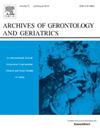The relationship between trajectories of intrinsic capacity and differences in the risk of functional ability decline in community-dwelling older adults: A socio-ecological approach
IF 3.5
3区 医学
Q2 GERIATRICS & GERONTOLOGY
引用次数: 0
Abstract
Background
Functional ability (FA), a key determinant of healthy aging, is determined by intrinsic capacity (IC), environmental factors, and their interactions. IC is a composite of physical and mental capacities that undergo constant change. Therefore, understanding the factors that influence IC requires a multi-level analysis of individuals to optimize its trajectory.
Methods
Individuals aged ≥ 65 were included in the Korean Longitudinal Study of Aging (2012–2020). Impaired IC (IIC) scores were tracked over eight years using latent class growth modeling to classify trajectory patterns. Determinants were identified through multinomial logistic regression. The relationship between IIC trajectory and FA decline was assessed using Kaplan-Meier analysis and the Cox proportional hazards model.
Results
Of the 7486 subjects, 2268 (mean age 72.26 [SD 5.31] years; female 56.4 %) were included after excluding those who were underage, had lost independence, or were missing baseline data. The IIC trajectories were categorized into four classes: low-persistent (Class 1, 48.46 %); low-increasing (Class 2, 17.46 %); high-decreasing (Class 3, 20.37 %); and high-stable (Class 4, 13.71 %). Over a mean follow-up of 7.21 years, 536 individuals experienced a decline in FA. After adjusting for confounders, the hazard ratios (HRs) were 1.95 (95 % CI 1.51–2.50) for class 2, 1.93 (1.50–2.46) for class 3, and 3.41 (2.64–4.39) for class 4 compared to class 1. Additionally, age, gender, marital status, employment, social participation, and living status had overlapping effects on both IC and FA.
Conclusions
Understanding the heterogeneity of IC, combined with multidomain interventions, can enable FA maintenance and promote healthy aging.
社区居住老年人内在能力轨迹与功能能力下降风险差异之间的关系:社会生态学方法。
背景:功能能力(FA)是健康老龄化的关键决定因素,它由内在能力(IC)、环境因素及其相互作用决定。智力是不断变化的生理和心理能力的综合。因此,了解影响IC的因素需要对个体进行多层次分析,以优化其发展轨迹。方法:年龄≥65岁的个体纳入韩国老龄化纵向研究(2012-2020)。使用潜在类别增长模型对轨迹模式进行分类,对受损IC (IIC)评分进行了八年的跟踪。通过多项逻辑回归确定决定因素。使用Kaplan-Meier分析和Cox比例风险模型评估IIC轨迹与FA下降之间的关系。结果:7486例受试者中,2268例(平均年龄72.26 [SD 5.31]岁);女性(56.4%)在排除了未成年、丧失自理能力或缺少基线资料的患者后纳入。IIC轨迹分为四类:低持续性(第1类,48.46%);低增长(第2类,17.46%);高递减(第3类,20.37%);高稳定型(第4类,13.71%)。在平均7.21年的随访中,536人经历了FA的下降。校正混杂因素后,与1类相比,2类的风险比(hr)为1.95 (95% CI 1.51-2.50), 3类为1.93 (95% CI 1.50-2.46), 4类为3.41 (95% CI 2.64-4.39)。此外,年龄、性别、婚姻状况、就业、社会参与和生活状况对IC和FA都有重叠影响。结论:了解IC的异质性,结合多领域干预,可以维持FA,促进健康老龄化。
本文章由计算机程序翻译,如有差异,请以英文原文为准。
求助全文
约1分钟内获得全文
求助全文
来源期刊
CiteScore
7.30
自引率
5.00%
发文量
198
审稿时长
16 days
期刊介绍:
Archives of Gerontology and Geriatrics provides a medium for the publication of papers from the fields of experimental gerontology and clinical and social geriatrics. The principal aim of the journal is to facilitate the exchange of information between specialists in these three fields of gerontological research. Experimental papers dealing with the basic mechanisms of aging at molecular, cellular, tissue or organ levels will be published.
Clinical papers will be accepted if they provide sufficiently new information or are of fundamental importance for the knowledge of human aging. Purely descriptive clinical papers will be accepted only if the results permit further interpretation. Papers dealing with anti-aging pharmacological preparations in humans are welcome. Papers on the social aspects of geriatrics will be accepted if they are of general interest regarding the epidemiology of aging and the efficiency and working methods of the social organizations for the health care of the elderly.

 求助内容:
求助内容: 应助结果提醒方式:
应助结果提醒方式:


